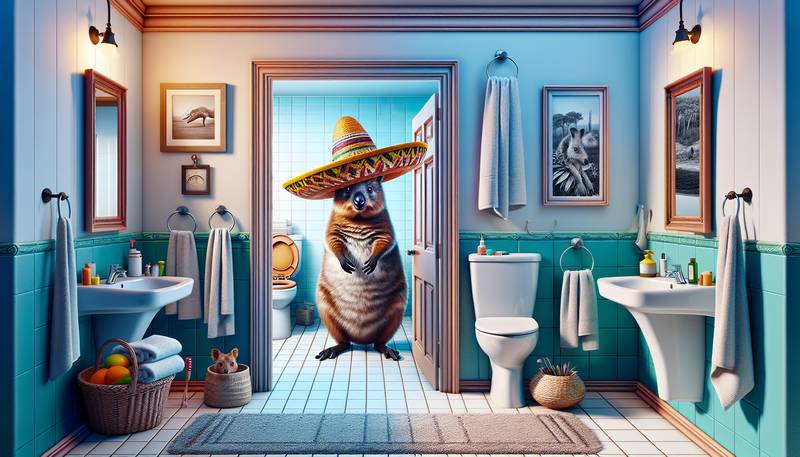Is Bad Design Still Design?

The Peculiar Charm of the InelegantDesign is often lauded for its ability to evoke emotion and inspire awe, but what happens when things go terribly wrong? Bad design exists out there, lurking in the shadows, waiting for unsuspecting victims—like a spider in the corner of a room you thought you had conquered. An old saying goes, “Beauty is in the eye of the beholder.” But is it possible for bad design to also wear the crown of beauty? Consider that time someone decided that a sign in the bathroom should feature both a quokka and a sombrero. Perhaps they were attempting to convey a carefree spirit, or more likely, they had a particularly confusing morning. What’s certain is that even the worst design can stir a chuckle or two—and laughter is the first step to understanding that not all design needs to win awards to make an impact.The Genius of AwkwardnessIt’s easy to dismiss designs that make you tilt your head, squint, or scratch your chin in bewilderment. Yet, there’s a unique brilliance in designs that defy convention. This is where 'bad' design can actually shine brighter than its elegant counterpart. The infamous “safety” sign that reads “Caution: Wet Floor—Use Extreme Caution” is a prime example. Someone had to sit down, nod, and type that out. - It gets the point across.- It's like a verbal high-five wrapped in caution tape.- It raises questions about what might happen if you don’t use “extreme” caution.This is the kind of design that can transform an ordinary day into a mini-adventure of thought. Who wouldn’t want to ask, “What happens if I don’t use extreme caution?” The possibilities are endless, and the best part? You might just slip into new ideas.Why Design Fails Can Be MemorableBad design isn’t just a phenomenon; it's a social experience. When you see a poorly designed product, there’s an involuntary urge to share it. It’s like a collective mission, akin to finding Waldo in a crowded, striped shirt convention. People gather around, gasping in disbelief, high-fiving each other over their discoveries. The internet is rife with examples of design mishaps:- Bathroom doors that swing outward with the sign 'Push.
- Product packaging that requires an advanced degree in geometry to open.
- Advertisements with typos that change the entire meaning—think “Free Ice Cream!” instead of “Free Ice Cream Samples!”
These designs remind us that mistakes can be entertaining. They become imprinted in our minds, leaving room for stories, laughter, and that special glimmer of creativity that might not have been sparked otherwise.A Matter of PerspectiveWhen we look at design through the lens of intention versus execution, a fascinating thing occurs. Sometimes, what seems like a colossal blunder was, in fact, a deliberate choice. A restaurant that insists on using neon green menus will certainly stand out—perhaps not in the best way, but definitely memorable. Imagine biting into a gourmet dish while squinting at the menu, wondering if you’re actually ordering a salad or an alien spaceship. There’s humor in that contrast, even if the restaurant's aesthetic leaves something to be desired. And who knows? That unexpected experience could lead to a lifelong love of quirky design. Bad design can provoke thought, laughter, and a nearly instinctual need to critique it. It compels us to engage in a conversation about why it failed and how it could be transformed into something better. Learning from Design DisastersWhile the charm of bad design can be entertaining, there’s also a chance to glean valuable insights for future projects. It’s like studying your older sibling's fashion faux pas and vowing to never wear socks with sandals. Here are some lessons that can be extracted from design blunders:- Always test your prototypes on a diverse audience—preferably not just your cat.
- Function should never be sacrificed for form; please remember this when designing anything involving a remote control.
- Humor can go a long way—just ensure it’s intentional and not an unfortunate accident.
In the world of design, failure can often lead to the greatest revelations. The messiest doodles on a napkin can sometimes spring forth the most ingenious ideas. Designing a Quirky FutureAs society continues to evolve, the definition of good design will naturally shift. What was once considered bad may soon be celebrated as cutting-edge creativity. After all, isn’t the ability to laugh at our missteps what keeps us moving forward? Next time you encounter a design that makes you chuckle or raises an eyebrow, take a moment. Instead of cringing, embrace the absurdity. After all, if life gives you lemons, you might as well design a squishy lemon-shaped stress ball. It could turn out to be your greatest creation yet!
|
|







